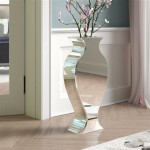Changing a Bathroom Mirror
Replacing a bathroom mirror can dramatically improve the aesthetic and functionality of the space. Whether seeking a stylistic upgrade or addressing a damaged mirror, understanding the process allows for a smooth and successful installation.
Assessing the Existing Mirror
Before purchasing a new mirror, careful measurements of the existing mirror are essential. Record the height and width accurately. Also, note the existing mounting method. Common methods include clips, adhesive, or a frame attached directly to the wall. Understanding the current setup helps in selecting an appropriate replacement and simplifies the removal process.
Inspecting the wall behind the existing mirror is also crucial. Look for any damage or imperfections. If the wall has sustained water damage or the previous installation involved significant modifications, repairs might be necessary before installing the new mirror. This preemptive assessment prevents complications during the installation process.
Removing the Old Mirror
Mirror removal requires careful handling to avoid breakage and injury. If the mirror is held by clips, carefully pry them away from the mirror's edges using a putty knife or a thin pry bar. If adhesive was used, applying heat with a hairdryer can soften the adhesive, making it easier to separate the mirror from the wall. A thin wire, like picture-hanging wire, can be worked behind the mirror to cut through the adhesive. For framed mirrors attached directly to the wall, locate and remove the screws holding the frame in place.
Throughout the removal process, using safety gloves and eye protection is crucial. A drop cloth placed below the mirror can protect the floor and contain any broken glass. If the mirror is large or particularly difficult to remove, seeking assistance from another person is recommended for safety and efficiency.
Once the mirror is detached from the wall, carefully remove any remaining adhesive or mounting hardware. A scraper can be used to remove stubborn adhesive residue, and patching compound can be used to fill any holes or imperfections in the wall, ensuring a smooth surface for the new mirror.
Choosing a New Bathroom Mirror
Selecting a new bathroom mirror involves considering both practical and aesthetic aspects. The size should be proportionate to the vanity and the overall bathroom size. Oversized mirrors can overwhelm a small space, while undersized mirrors may not provide adequate functionality. Reflecting on the bathroom's lighting is also important. A larger mirror can enhance the brightness in a dimly lit bathroom.
Style considerations are equally important. Frameless mirrors offer a sleek and modern appearance, while framed mirrors can add a decorative touch, complementing the bathroom's existing décor. Consider the style of the vanity, lighting fixtures, and other accessories when selecting a frame style and finish. The mirror's shape—rectangular, oval, round, or square—should also harmonize with the overall design.
Exploring available features can enhance the functionality and convenience of the new mirror. Mirrors with built-in lighting, defoggers, or magnification options can provide added value. Consider these features based on individual needs and the bathroom's existing setup.
Installing the New Mirror
Before starting the installation, read the manufacturer's instructions carefully as they might provide specific guidelines. The most common installation methods are clips, adhesive, and direct mounting with screws. If using clips, ensure they are positioned correctly and securely fastened to the wall. For adhesive mounting, apply the adhesive evenly to the back of the mirror, following the manufacturer's recommendations for application and drying time.
When mounting a framed mirror directly to the wall, ensure the frame has appropriate mounting points. Use suitable screws and wall anchors to provide a secure and stable installation. A level should be used throughout the process to ensure the mirror hangs straight. Accurate measurements and careful placement are essential for a professional-looking result.
After the installation is complete, inspect the mirror to ensure it is securely attached and level. Clean the mirror surface with a glass cleaner to remove any fingerprints or smudges, revealing its pristine appearance and enhancing the overall bathroom aesthetic.

How To Remove A Bathroom Mirror Lowe S

How To Safely And Easily Remove A Large Bathroom Builder Mirror From The Wall Site Title

How To Remove Glass Mirror From Your Bathroom Wall Doctor

Before After Bathroom Mirror Makeovers Hooked On Houses

Vanity Mirror Makeover Changes The Look Of Your Bathroom Mirrorchic

How To Safely And Easily Remove A Large Bathroom Builder Mirror From The Wall Site Title
:strip_icc()/Design_CathieHongInteriorsPhoto_ChristyQPhotography-b2290decbe0e4d0b952f280fb7bdc896.jpg?strip=all)
How To Remove A Bathroom Mirror From The Wall

How To Remove A Bathroom Mirror Lowe S

How To Professionally Install A Bathroom Mirror

How To Update A Builder Grade Bathroom Mirror Peacock Ridge Farm








